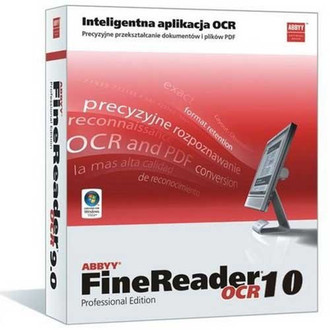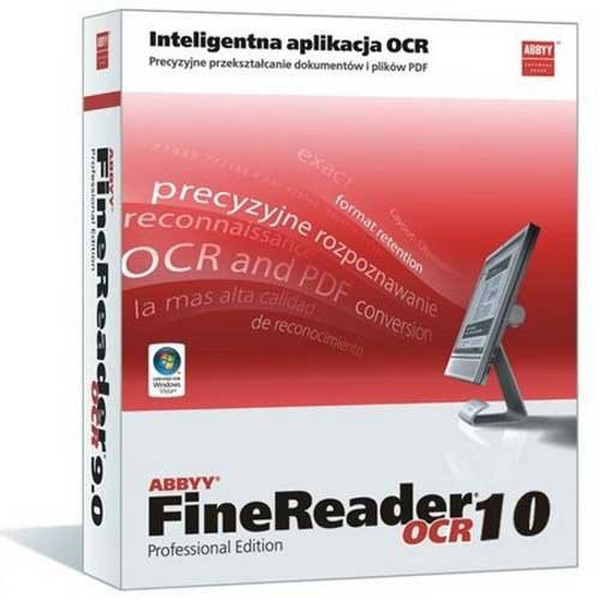目錄的
-
目錄的
- Antiquitäten & Kunst
- Auto & Motorrad: Fahrzeuge
- Baby
- Bücher
- Camping & Outdoor
- Feinschmecker
- Haustierbedarf
- Heimwerken & Garten
- IT和电子
- Kleidung & Accessoires
- Modellbau
- Musik
- PC- & Videospiele
- Sammeln & Seltenes
- Spielzeug
- TV, Video, DVD
- Telekommunikation
- Uhren & Schmuck
- Wellness & Beauty
- fashion & lifestyle
- institutional food services equipment
- medical equipment, accessories & supplies
- 个人护理
- 休闲爱好
- 办公设备,用品和配件
- 商业与工业
- 家居,建筑,装修
- 家用电器
- 摩托车及配件
- 武器和弹药
- 照相机
- 花园和庭院
- 运动,娱乐及休闲
- 食物
- 高保真音響
Filters
Search
ABBYY Finereader XIX
凡购买和价格 (Advertising *)
顶部
技术特点
顶部
系统要求
| 最低内存 | 64 MB |
|---|---|
| 最小硬盘空间 | 230 MB |
| Mac兼容性 | N |
| 最低处理器 | Pentium/Celeron/Xeon, AMD K6/Athlon/Duron |
技术细节
| 软件类型 | Box |
|---|---|
| 支持的介质类型 | Microsoft Word XP, 2000, 97, 95, * RTF * TXT * Unicode Text * MicrosoftExcel XP, 2000, 97, 95 * HTML 3.2/4.0 * Unicode HTML 3.2/4.0 * DBF * CSV * PDF 3.0/4.0 |
Finereader XIX
First Omnifont OCR for Fraktur and Old European Script Recognition
ABBYY FineReader XIX is a special version of the award-winning FineReader optical character recognition (OCR) software for recognising "fraktur" or "black letter" texts from the period between 1800 and 1938. It is designed to convert scans of old documents, books, and papers into text for the purpose of digital archiving and publishing, and it is the first omnifont OCR software for Fraktur.
The Challenge: Digitising Old Texts
Until recently, the limitations of technology and the unique characteristics of text written in a variety of old-fashioned fonts and scripts have made it difficult to automate the process of recording this information via computer. Sophisticated OCR dictionaries, language models used for analysing and verifying text written during this time period, have not existed. Computer systems capable of reading old texts have required many hours of systematic training to recognise fonts and characters that are no longer used in modern printing.
Black letter fonts, also known as "Gebrochene Schriften" or broken scripts, first emerged in as early as the 12th century, and evolved over the years to host a variety of derivations and font types. The Fraktur typeface, dominant in Germany, was created on behalf of the German Emporer Maximilian and soon became popular in many parts of Europe. Common characteristics and peculiarities of the type include the elongated s and ligatures, "joined" letters for certain letter combinations. The frequency of its application makes understanding of Fraktur essential for studying text and developing recognition technologies for the period between 1800 and 1938.
The Solution: First Omnifont OCR for Fraktur
ABBYY FineReader XIX is the first omnifont OCR for Fraktur, giving users a solution for scanning and converting old documents with minimal training and dictionary work. This was achieved by combining extremely intelligent technology with dedicated linguistic study:
OCR systems work by analysing a text image and making a hypothesis about which letter or word an image represents. The hypotheses are analysed in context and verified by use of sophisticated OCR dictionaries made up of Language Models (LMs). Language Models (LM) are computer databases that describe the vocabulary of a language. The problem is that modern OCR systems do not have LMs for older text fonts and older text spellings. The solution for Fraktur text recognition was achieved through the development of OCR dictionaries specifically for this time period. Special language models were created for five European languages.
The Fraktur language models were created with the help of ABBYY partner, ATAPY Software. Through development process, 10 different dictionaries and more than 105 books published between 1 808 and 1 930 were analysed. Linguists reviewed word stock, identified words that have phased out through the evolution of the languages, and identified the correct paradigm assignments for synchronising the language models with the appropriate grammar usage for the time period. More than 500.000 word entries were manually compared with existing FineReader dictionaries.
Grammatical paradigms and word evolutions were reviewed to add 159 historic grammar paradigms that were missing from the contemporary language models. Language models were then compiled and tested on a control group of testing documents featuring old text.
To recognise the Fraktur style fonts, ABBYY development teams created special classifiers, or alphabets, capable of recognising the Fraktur symbols. As part of this effort, ABBYY development teams collected a symbol image base with an average of 2500 symbol samples for each symbol, a new alphabet pattern, and collected and input a sample test base representing 31000 pages of text from different sources. Using the sample text, the recognition engine was "fine-tuned" to work with the subtle features of the Fraktur alphabet (such as the ligatures, or connected letters). The new alphabet was then added to the FineReader system and interface and tested extensively.
Created in cooperation with major archiving institutions
ABBYY FineReader XIX was also developed with the needs of universities and research center in mind. The product was developed through a cooperation with the worldwide METAe Project. METAe is a consortium of libraries and digitisation companies from across Europe who are working together to create the METAe Engine, a software package specifically designed for organising the work flow of the archiving and conversion of historical materials such as books, journals, magazines and news- papers. ABBYY FineReader XIX will provide a key component for archiving some of Europe's most priceless historical documents. Partners in the METAe project include: the Univeristy of Innsbruck (Austria), University of Florence (Italy) Bibliotéque Nationale de France, the National Library of Norway, the Freiedrich-Ebert-Foundation (Germany), CCS Compact Computer Systeme (Germany), and Cornell Library University (USA).
ABBYY FineReader XIX is a special version of the award-winning FineReader optical character recognition (OCR) software for recognising "fraktur" or "black letter" texts from the period between 1800 and 1938. It is designed to convert scans of old documents, books, and papers into text for the purpose of digital archiving and publishing, and it is the first omnifont OCR software for Fraktur.
The Challenge: Digitising Old Texts
Until recently, the limitations of technology and the unique characteristics of text written in a variety of old-fashioned fonts and scripts have made it difficult to automate the process of recording this information via computer. Sophisticated OCR dictionaries, language models used for analysing and verifying text written during this time period, have not existed. Computer systems capable of reading old texts have required many hours of systematic training to recognise fonts and characters that are no longer used in modern printing.
Black letter fonts, also known as "Gebrochene Schriften" or broken scripts, first emerged in as early as the 12th century, and evolved over the years to host a variety of derivations and font types. The Fraktur typeface, dominant in Germany, was created on behalf of the German Emporer Maximilian and soon became popular in many parts of Europe. Common characteristics and peculiarities of the type include the elongated s and ligatures, "joined" letters for certain letter combinations. The frequency of its application makes understanding of Fraktur essential for studying text and developing recognition technologies for the period between 1800 and 1938.
The Solution: First Omnifont OCR for Fraktur
ABBYY FineReader XIX is the first omnifont OCR for Fraktur, giving users a solution for scanning and converting old documents with minimal training and dictionary work. This was achieved by combining extremely intelligent technology with dedicated linguistic study:
OCR systems work by analysing a text image and making a hypothesis about which letter or word an image represents. The hypotheses are analysed in context and verified by use of sophisticated OCR dictionaries made up of Language Models (LMs). Language Models (LM) are computer databases that describe the vocabulary of a language. The problem is that modern OCR systems do not have LMs for older text fonts and older text spellings. The solution for Fraktur text recognition was achieved through the development of OCR dictionaries specifically for this time period. Special language models were created for five European languages.
The Fraktur language models were created with the help of ABBYY partner, ATAPY Software. Through development process, 10 different dictionaries and more than 105 books published between 1 808 and 1 930 were analysed. Linguists reviewed word stock, identified words that have phased out through the evolution of the languages, and identified the correct paradigm assignments for synchronising the language models with the appropriate grammar usage for the time period. More than 500.000 word entries were manually compared with existing FineReader dictionaries.
Grammatical paradigms and word evolutions were reviewed to add 159 historic grammar paradigms that were missing from the contemporary language models. Language models were then compiled and tested on a control group of testing documents featuring old text.
To recognise the Fraktur style fonts, ABBYY development teams created special classifiers, or alphabets, capable of recognising the Fraktur symbols. As part of this effort, ABBYY development teams collected a symbol image base with an average of 2500 symbol samples for each symbol, a new alphabet pattern, and collected and input a sample test base representing 31000 pages of text from different sources. Using the sample text, the recognition engine was "fine-tuned" to work with the subtle features of the Fraktur alphabet (such as the ligatures, or connected letters). The new alphabet was then added to the FineReader system and interface and tested extensively.
Created in cooperation with major archiving institutions
ABBYY FineReader XIX was also developed with the needs of universities and research center in mind. The product was developed through a cooperation with the worldwide METAe Project. METAe is a consortium of libraries and digitisation companies from across Europe who are working together to create the METAe Engine, a software package specifically designed for organising the work flow of the archiving and conversion of historical materials such as books, journals, magazines and news- papers. ABBYY FineReader XIX will provide a key component for archiving some of Europe's most priceless historical documents. Partners in the METAe project include: the Univeristy of Innsbruck (Austria), University of Florence (Italy) Bibliotéque Nationale de France, the National Library of Norway, the Freiedrich-Ebert-Foundation (Germany), CCS Compact Computer Systeme (Germany), and Cornell Library University (USA).
-
支付方式
我们接受:











